6 min read
For Pilots Only: April 13, 2024
Connecting the Dots
It's been a tough news week in the world of flying, and I've got three stories that are sure to grab your attention.First up,...
9 min read
James Onieal & Jason DuVernay
:
Mar 29, 2020 12:36:27 PM
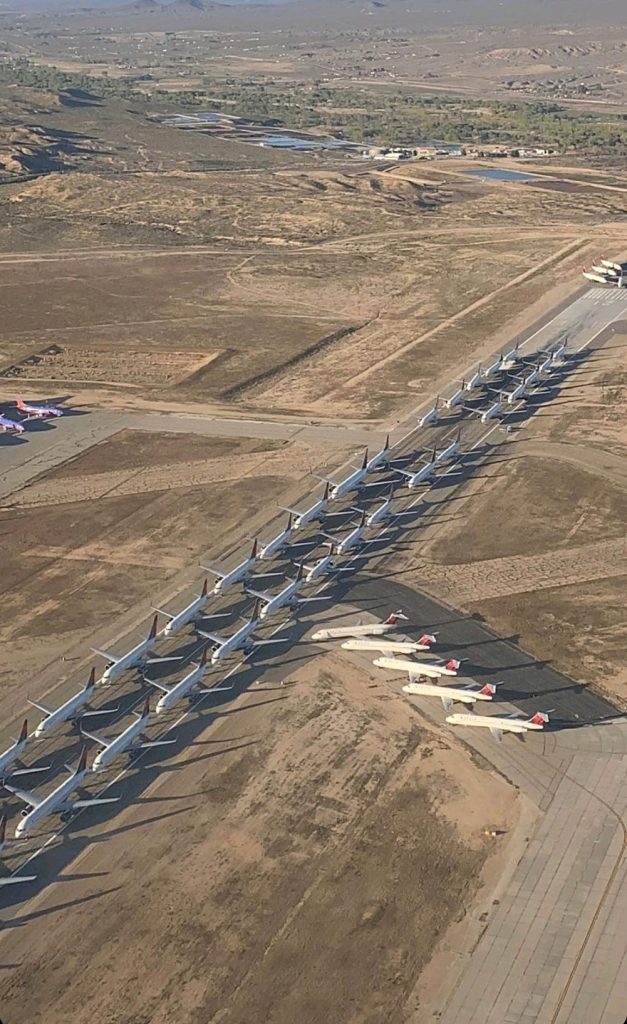
Now is not the time for counterfeit sincerity or selling products and services. It is, however, the time for us to collectively figure out how to calm down, avoid hurting each other, and start getting ready to pick up the pieces when this is all over. On that note, how do we make safe decisions in the midst of chaos? How do we know we’re making the right decisions? What are 5 things you can start doing immediately to protect yourself, your family, and your livelihood?
This week, like last week, has brought increasingly disastrous news with a few glimmers of positivity. Here’s the latest:
**Information is constantly changing, and we will continue to update as we progress**
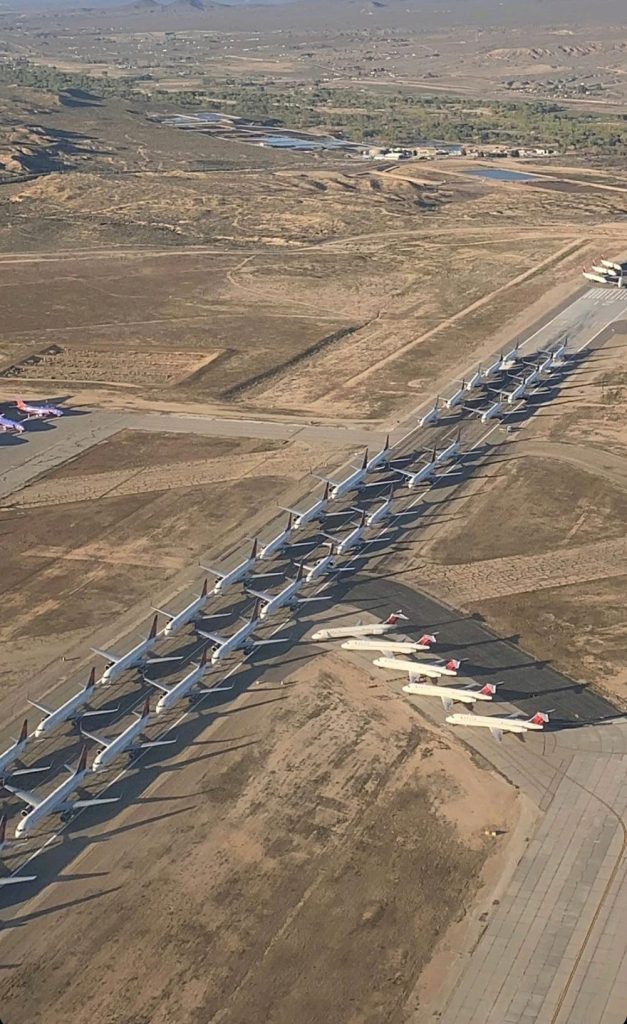 The CARES Act Bailout Details:
The CARES Act Bailout Details:
To put the Coronavirus effects in context, the current industry downturn is maintaining a decrease that’s triple the loss experienced in late 2001, dwarfing 9/11 in comparison. Keeping this in mind, it’s still unclear how similar these two events will be. We have yet to reach the peak of the Coronavirus effects in the U.S. and previous infection and fatality estimates are proving to be wildly inaccurate. All signs point to New York as the current virus hotbed; their medical system is overwhelmed, projections show their infection curve worsening compared to initial estimates, and their infection apex isn’t forecasted to come until mid April. Other state Governors have already begun quarantining visitors from New York as they enter to keep their own residents safe. This recent news all points to us still having considerable unknowns hanging out there.
These unknown unknowns (when we don’t know what we don’t know) are precisely why we can’t take stability for granted right now. Unknown unknowns are also why we need to start asking calibrated questions to gain a better perspective on what’s happening to our industry. Questions like: How bad will this downturn get? And, how long will this downturn last? There was a 152x multiplier on individuals that experienced PTSD post 9/11 vs. the Americans that died in the attacks. It is unknown what extended psychological consequences will exist post Coronavirus but the outstanding question remains; will your friends, family, neighbors be willing to purchase airline tickets when this is all over? Seems an important indicator of how quickly, or not, the industry will recover.
According to the Bureau of Transportation Statistics, “in the August preceding 9/11, the airline industry experienced what was then a record high in the number of airline passengers for a given month when 65.4 million travelers took to the air. After 9/11, that number trailed off dramatically, and it took nearly 3 years, until July 2004, for the industry to match and finally surpass the pre-9/11 levels.”
For comparison, according to Airlines for America:
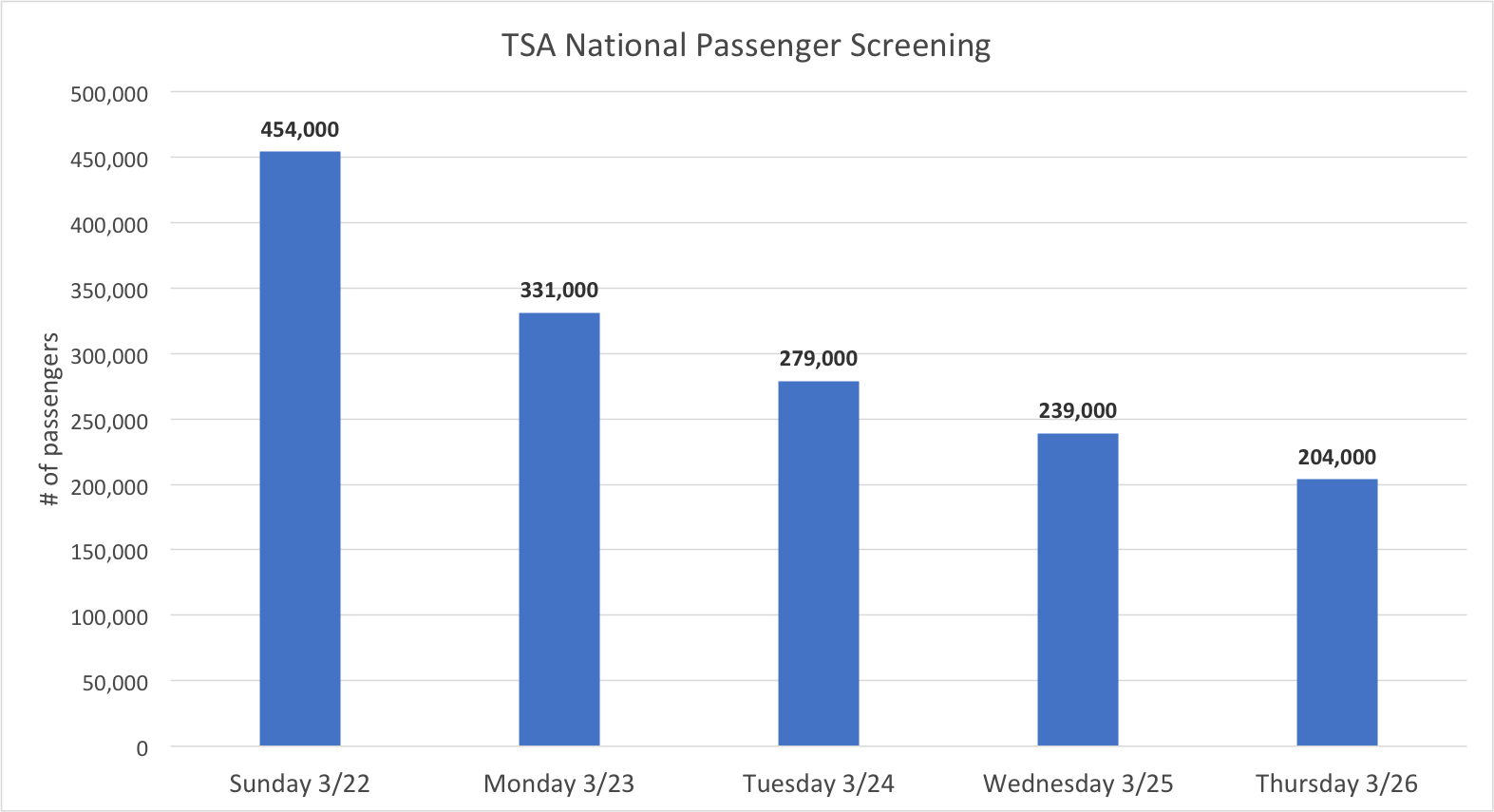
“This situation is getting worse each day with no end in sight.”
“The global economy has taken a big hit, and we don’t expect travel demand to snap back for some time,” wrote CEO Oscar Munoz and United’s president, Scott Kirby. “That means being honest, fair and upfront with you: if the recovery is as slow as we fear, it means our airline and our workforce will have to be smaller than it is today.”
“ALPA pilots applaud the fact that the economic relief package contains provisions to limit furloughs, protect our contracts, and ensure that federal assistance is used to pay airline employees” said Captain Joe DePete, ALPA president.
Ed Bastian, Delta Air Lines CEO recently said: “While this assistance is welcome, it’s important to remember that the relief package is not a cure for the unprecedented challenges we face.” Adding to this, CFO Paul Jacobson bolstered Bastian’s point by saying, “we’re going to be smaller coming out of this. Certainly quite a bit smaller than when we went into it.”
To better understand today’s risks and learn more, let’s look back at the actions taken by management, government, and unions immediately after 9/11:
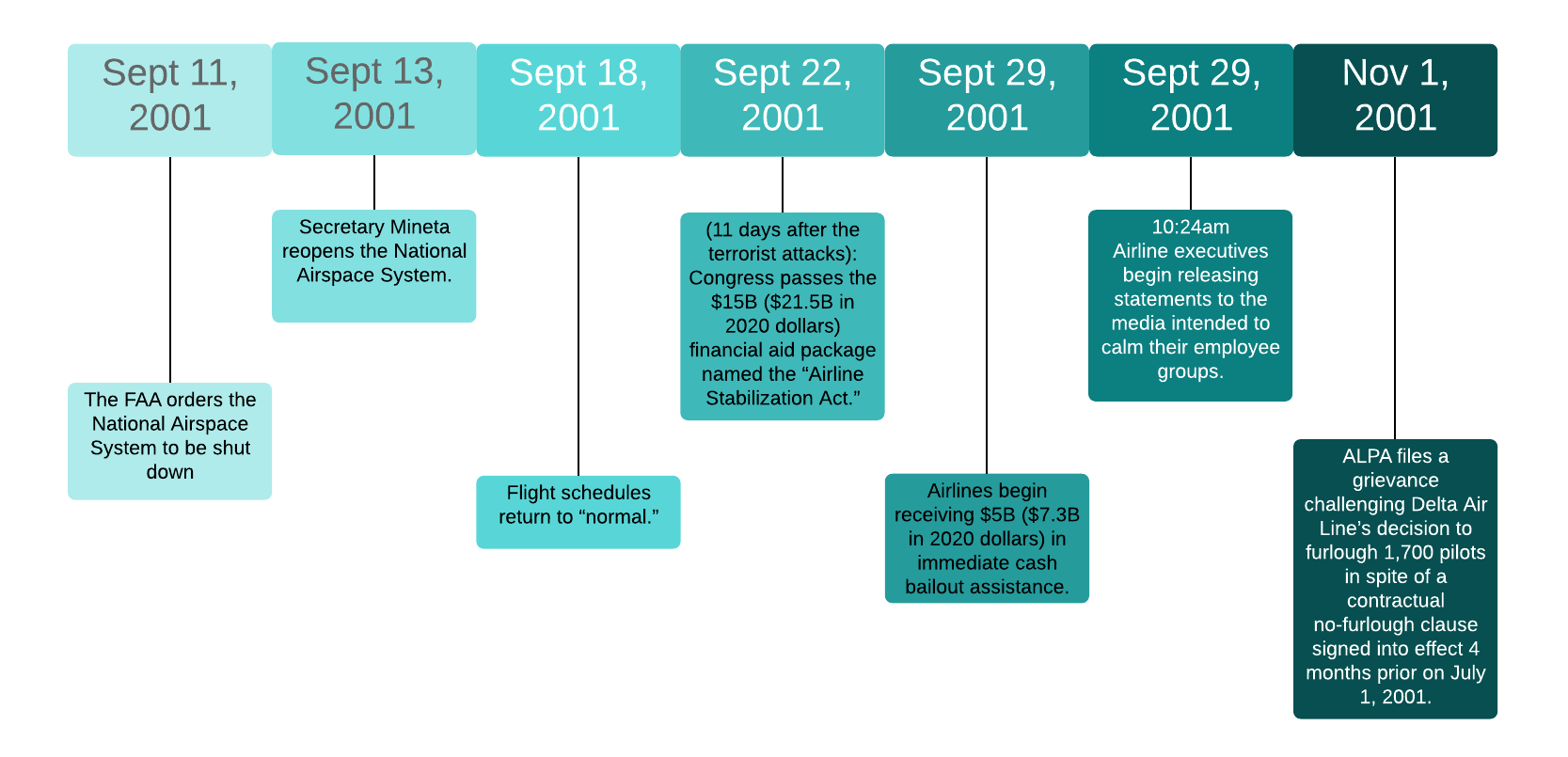 As you can see, the National Airspace System was only shut down for 3 days with flights returning back to “normal” within a relatively quick 7 day span. Congress acted within 11 days to secure bailout funds designed to keep the airlines afloat. Here we are, over 4 weeks later, and airlines have been cutting flights since late February while Congress drags their feet, taking double the time needed in 2001 to approve a critical bailout package. Will these efforts be enough? If so, for how long?
As you can see, the National Airspace System was only shut down for 3 days with flights returning back to “normal” within a relatively quick 7 day span. Congress acted within 11 days to secure bailout funds designed to keep the airlines afloat. Here we are, over 4 weeks later, and airlines have been cutting flights since late February while Congress drags their feet, taking double the time needed in 2001 to approve a critical bailout package. Will these efforts be enough? If so, for how long?
As of today, while the National Airspace System is technically open, passengers are either prohibited from, or afraid to, use it. Almost no one is flying, and it is questionable whether the airspace will remain open or be shut down completely as this epidemic continues. Even ALPA, the nation’s largest union representing a majority of U.S. airline pilots, is gloomy on the outlook. Given the quote above from Captain Joe DePete, ALPA President, the union is not looking to prevent furloughs, merely to limit them.
Airline executives are notoriously full of sunshine right up until the exact moment the music stops. What does it mean when executives are as doom and gloom as they are now? Even Delta, the legacy airline with the least amount of debt, recently had their credit rating reduced to junk by S&P, just like United did back in 2001. We know the turmoil that was created right after 9/11 by multiple furloughs and bankruptcies. How will the airlines navigate these new challenges with significantly stronger headwinds? Will there be any flowback from the majors to their regional partner airlines (Jets for Jobs v2.0)? Will any of the majors turn down bailout money to keep bankruptcy on the table?2001 Quotes from Executives & AnalystsHere are some relevant facts and quotes made by airline executives and industry analysts in 2001 just prior to the massive pilot furloughs that came shortly thereafter:
Right now, fear and anxiety, due to the lack of predictability in our current day to day lives is driving people to make some really bad decisions. The discomfort created by not knowing what’s coming next is maddening, and the inability to tolerate this discomfort, can drive you into making really harmful decisions that will hurt in the long run. To keep things simple, let’s think about our current situation in the context of the “Hold scene” from the movie Braveheart. You know, the scene where Mel Gibson’s character, William Wallace, has his men sitting still, crouching seemingly vulnerably, while the English horsemen charge towards them at full speed, fully armored and wielding deadly swords. All the while, William Wallace stands defiantly, screaming “hold,” until the exact right moment, when his men quickly, and precisely, pick up their sharpened wooden spears, decimating their enemy in a feat of steely eyed strength.
In this example, I’d like you to think of the Noblemen, the ones commanding the army and riding gleefully around on their horses, in the beginning of the scene, as the Coronavirus. Standing there in front of these noblemen, on full display, is the largest, most formidable land army the world has ever seen. Filled with archers, horsemen, and assault troops, each equipped with state of the art armament and weaponry. In this case, this land army represents the economic effects of the Coronavirus...formidable and capable of imposing sheer devastation on any enemy that stands in its way. As for William Wallace’s men, they are a group of loosely arranged clans, all working together to defeat a common enemy, the British. In our world, these clans represent the loosely associated groups of pilots. Each of them coming from different airlines, corporate, and military positions, all looking to keep their careers on track. As for William Wallace, we’ll be playing that role here at Raven, telling you to hold until the exact right moment.
Now, I’d like you to put yourself in the shoes of Wallace’s men. They’re rag-tag, poorly trained and armored compared to their British counterparts, and are left sitting, seemingly without protection in an incredibly vulnerable position, out in the middle of an open battlefield. Standing there, like livestock waiting to be slaughtered, they wait for the British cavalry to arrive as they charge them at full speed. While they stand there in fear, they begin to hear the thundering horse hooves at the exact same time as they begin to feel the ground beneath them tremble. As they look towards the horizon, they can soon see the fleet of horses quickly getting closer and closer. At this point, they know they’re in for a lot of pain...even worse, if they get this wrong, many will die. The problem is, they know if they charge the oncoming fleet of horses, or if they turn and run, they’ll all get slaughtered. So instead, they stand there, waiting, all the while trembling in fear and uncertainty as to what their future holds.
Nonetheless, at the exact right moment, when the charging calvary is within arms reach, where they can no longer reverse course, when Wallace’s men can see the whites of their eyes, his men crouch and quickly rise, jamming their spears into their enemy, decimating them on the spot. It turns out that rag-tag groups of men were actually strategically fortified, they simply looked vulnerable. In reality, they were in the perfect position to strike when the moment was right, dealing a fatal blow that limited harm and casualties to their side. That’s why, right now, in this absurdly terrifying moment, where you can feel the ground trembling beneath you while hearing the roar of an unstable economy charging towards you, we’ll be right there alongside you screaming HOLD, until the exact right moment.
We don’t want to see you get hurt and we know if you take certain decisive actions now, you can limit your exposure to harm.
“You go to war with what you have, not with what you need.
BUT
Before you go to war, you make all the preparations you can.”
- N.Y. Governor Andrew Cuomo
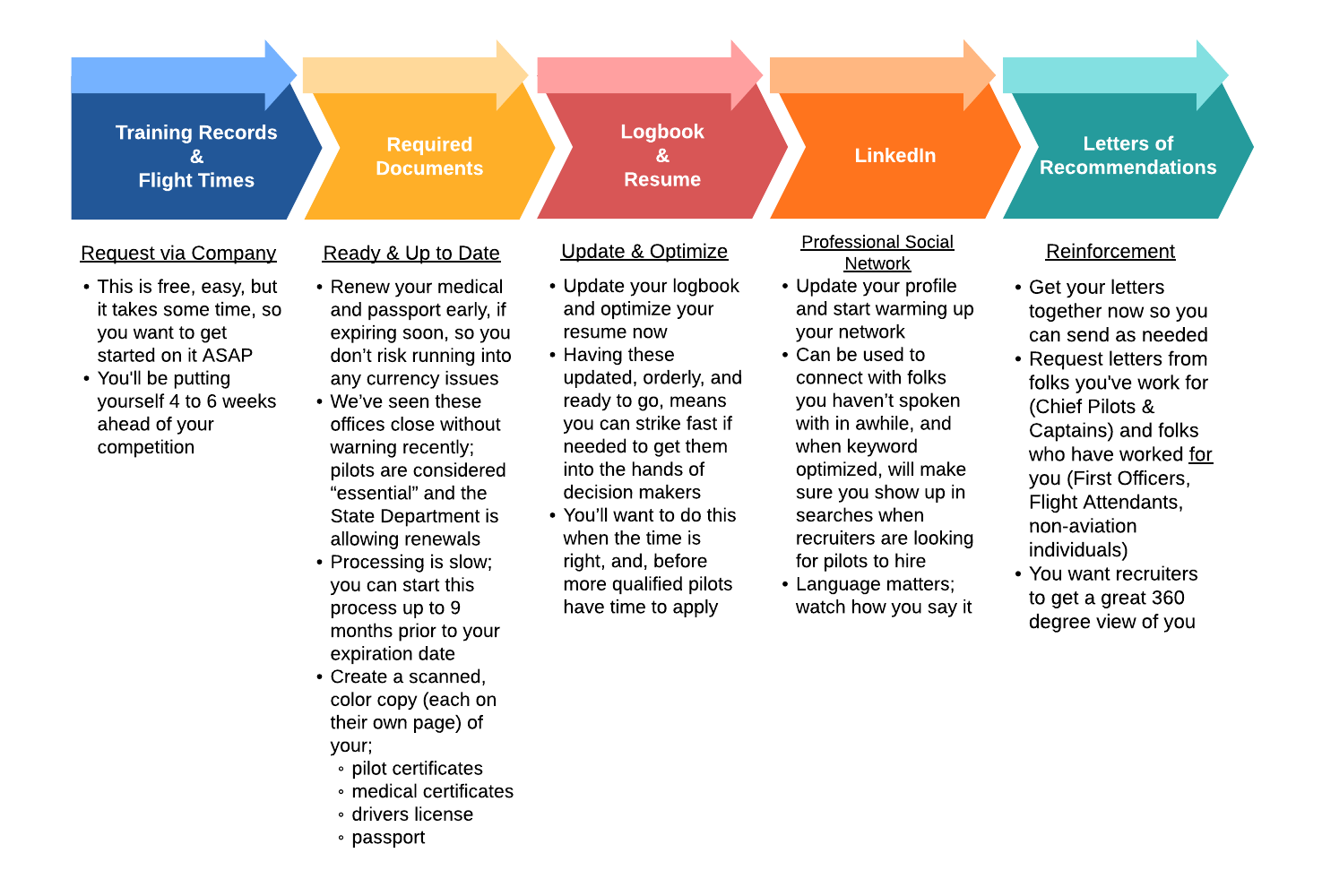
As many of you know, we are in for a bumpy ride, and there will likely be less jobs than there are pilots when large furloughs start kicking off. We won’t know what the effects of the Coronavirus will look like for a few more months, likely during the summertime. For now, while the ground is rumbling and noise intensifies, arrange your spears and hold the line. When the time is right, you’ll know, and have done all the prep work needed to sense when the time is right to raise your spears and strike a deadly blow.
Until then...HOLD!
How Does the Coronavirus Compare to 9/11?
How to Survive Disruptive Change
Are Furloughs Coming?
What Should Pilots Do In These Uncertain Times?
6 min read
It's been a tough news week in the world of flying, and I've got three stories that are sure to grab your attention.First up,...
3 min read
It's been a wild ride in the cargo world lately, and if you're like me, you've been keeping a close eye on the news. The...
3 min read
Right now it's time to play the long game. While everyone else is sleeping and waiting, you’re fighting for your spot at the top.